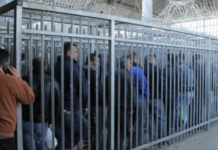
Announce protest actions, general chit chat or give your opinion on issues we haven’t covered for the day.
Moderation rules are more lenient for this section, but try and play nicely.
EDITORS NOTE: – By the way, here’s a list of shit that will get your comment dumped. Sexist language, homophobic language, racist language, anti-muslim hate, transphobic language, Chemtrails, 9/11 truthers, climate deniers, anti-fluoride fanatics, anti-vaxxer lunatics and ANYONE that links to fucking infowar.






For more on the neocon origins of the blame the Wuhan lab meme.
https://www.moonofalabama.org/2020/05/how-the-trump-administration-inserts-blame-china-propaganda-into-main-stream-media.html#more
I haven’t been on-site much these past couple of days, but the coincidence of; the budget and; Pandemic Alert Level reduction, is just too big a political day to ignore! Blog-commenting is a strange ephemeral activity. But at least people here who delve into these reflections; rather than simply reading the main texts and getting on with their days, are essentially consenting partners in a game (though not always the same one). I suppose it’s better than bombarding friends and family with my assortment of semi-comprehended facts and flimsy conjectures.
There was a new Contrapoints film (in that it’s a video presentation nearly an hour and a half long) out this week. Which really got me thinking about my motivations for participating in online dialogues. So I guess that’s successful art:
https://m.youtube.com/watch?v=vRBsaJPkt2Q
I’m thinking of how technology is taking over, and the willingness to adopt the narrow, machine-mind approach along of course with the upperclass disdain verging on the puritanical for those perceived to be lower class.
But Singapore dog control – techno type is another chilling Asian method of control. The USA just shot people on campus during Vietnam furore.
Anyway the Salvation Army is concerned about our lack of spirituality and human love that is prevalent in current law. http://community.scoop.co.nz/2020/05/salvation-army-concerned-over-lack-of-cultural-and-spiritual-consideration-in-covid-19-response-bill/
Perhaps we should have a public test filmed by the Press gallery where all politicians should prick themselves to show that they bleed like the rest of us. The Shakespeare line comes to mind:
“If you prick us, do we not bleed? if you tickle us, do we not laugh? if you poison us, do we not die? and if you wrong us, shall we not revenge?”. – (Act III, scene I).” The Merchant of Venice.
I want thinking, feeling, practical, educated and concerned human beings making laws for others. Not the twisted minds of Trump or technocrats and economists under neolib domination, living in model bubbles, afraid to come out and be overwhelmed by the germs of ordinary society – War of the Worlds!
Tedtalk https://www.youtube.com/watch?v=VNGFep6rncY
Why don’t you do, think different things? Mental myopia, tunnel vision – 95% of our time we are on automatic pilot. Why the majority is always wrong | Paul Rulkens | TEDxMaastricht
Wage subsidy series
Part 2: Taranaki business Covid wage subsidies
Prepared by Jody
Summary
The number of Taranaki businesses applying for the New Zealand Government 2020 Covid wage subsidy was investigated. A sample of Taranaki businesses were compiled using the Yellow pages directory and were confirmed as drawing a subsidy by matching their name on the Ministry of Social Development public wage subsidy database. The business receiving the subsidy, number of affected staff and amount drawn were then recorded.
As at 27 April 2020, 20.4% or 1003 of 4921 unique Taranaki businesses had applied for the wage subsidy. These businesses included those registered in the same name but at multiple locations within the region, and enterprises such as franchise and chain stores who may not be headquartered in Taranaki.
The total amount of subsidy drawn by these 1003 businesses was NZ$412,438,897 while the number of subsidised employees (includes staff outside of the region) was 63,953. Of the 1003 businesses, 11 businesses alone accounted for 50% of the total regional subsidy drawn and also for 50% of total subsidised employees (the amount of subsidy drawn and number of staff was proportional). 100 businesses accounted for 83% of subsidy drawn. This agrees with Statistics New Zealand (2018) which states less than 1% of NZ enterprises have 100 or more employees but these businesses employed 48% of the population. Statistics NZ also state that 1% of enterprises have 50 to 99 employees, a medium sized business defined by Grant Thornton, 2019. The median amount of subsidy drawn per all businesses was NZ$49,207 while for the bottom 90% of participating businesses (by amount drawn) it was NZ$46,378. The median number of employees per all subsidised businesses was 8 and for the bottom 90% of subsidised businesses was 7.
Only 11% of the top 100 subsidised businesses by amount drawn were headquartered in Taranaki (one third of the 100 had overseas holding companies) and none of the eight largest Taranaki employers (300+ employees, ENZ.org, n.d.) drew a subsidy. An attempt was made to account for the businesses and associated staff not actually present in the region (the relationship between business rank (x) and subsidy drawn (y) was logarithmic which flattened rapidly after about 100 businesses). Using the amount of subsidy drawn and staff numbers from the bottom 90% of participating businesses, assumed as more representative of business profile with small to medium characteristics (903 businesses with 77 staff or less, with one outlier of 206 staff), data was adjusted to produce amount of Taranaki subsidy:
Total amount of subsidy drawn by 1003 Taranaki businesses (adjusted) = 100/90 * $69498466 = $77,220,518 = less than 1% of total government wage subsidy spend
Average subsidy per business (1003 total) = $76,990 = the equivalent of 11 full time employees over 12 weeks
Applying the same adjustment to employees:
Total number of affected employees = 100/90 * 10560 = 11,733 = 23% of Taranaki’s 51300 employees
Average number employees per subsidised business = 12
Method
4921 business names were taken from the 2018/2019 Taranaki Yellow Pages and were current as of the publication date of the phone book. Between 20 April 2020 and 27 April 2020, the unique business names were searched for in the NZ Government MSD Wage Subsidy database and their presence, amount drawn and number of staff involved were recorded.
Results
-4921 businesses compiled representative of all sectors defined by Statistics New Zealand
-Number of subsidised businesses with intra-region replicates = 1162
-Number of subsidised businesses, unique within region = 1003
-Percent of total unique businesses being subsidised = 20.4%
-Total number employees in unique subsidised businesses = 63,953
-Number employees bottom 90% of unique subsidised businesses = 10,560
-Median number employees per unique subsidised business = 8
-Median number employees per bottom 90% of unique subsidised = 7
-Mean number employees per bottom 90% of unique subsidised = 12
-Total subsidy drawn all unique businesses = 412,438,897
-Amount subsidy bottom 90% of unique subsidised businesses = 69,498,466
-Median subsidy drawn per unique subsidised business = 49,207
-Median subsidy drawn per bottom 90% of unique subsidised = 46,378
-Mean subsidy drawn per bottom 90% of unique subsidised = 77049
-Number of Taranaki-based headquarters in top 10% (100) of unique businesses by subsidy amount = 11
-Number of NZ-based holding companies/owners in top 10% (100) of businesses by subsidy amount = 68
-Number of top 100 Taranaki subsidised businesses also in top 100 national businesses employing the most staff = 6, found at national employer ranks 5, 15, 25, 40, 63 and 70; and Taranaki subsidy ranks 1, 3, 2, 4, 88, 8 respectively (Katalyst, n.d.)
-Number of subsidised business names containing Taranaki area postcode or suburb identifiers (one of 129 directory/geographical names e.g. ‘new plymouth’) = 1124 of 4921 businesses
-Business names containing ‘zealand’ = 78 of 4921 businesses
Limitations and possible errors
-Compiled database of Taranaki businesses incorrect or incomplete (database error)
-Taranaki business identified in MSD database were not accurately matched or were missed (accuracy error)
-MSD database set may have been updated after this comparison study completed; use of reference data more than one year old (currency error)
-Used informal methods amd selected data to modify Taranaki business characteristics (research design and assumption errors)
-Difference between number of Yellow pages unique businesses (4921) and Venture Taranaki stated number of businesses (15315) i.e. totality of business survey (completeness error)
Discussion
The true total amount of subsidy drawn down by Taranaki businesses probably lies somewhere between the maximum for 51300 full time employees for 12 weeks (1/30 of the total national subsidy or $360 million) and the adjusted $77 million (21% of maximum) found in this study. Accuracy depends on establishing the true number of Taranaki businesses and their employee need, as well as the discovery methods; if the Venture Taranaki data for the number of businesses is accurate then this study could have underestimated the business numbers and proportionally the subsidy applications by up to a factor of three.
Nationally Taranaki accounts for 2% of population, 3% of GDP, 3% of businesses, 2% of employees and 5% of all unemployed (Notes 1 – 5). Regionally the adjusted subsidy drawn of $77 million was well below the GDP output equivalent for the province which if positively adumbrating one hopes would be a factor of regional economic resilience rather than local experimental error. Whether the Covid subsidy data can also be used as a portent of regional business situation other than at this extraordinary instant rather than as underlying economic conditions manifesting prior to lockdown remains to be seen. Similarly using the Taranaki data as a wider national business sentiment may need to be established at enterprise level within affected sectors e.g. tourism. The Covid emergency may also influence population health, economy, employment and other local and international industries variably for some time.
References
ENZ.org. (n.d.). Major New Plymouth employers. Retrieved from
https://www.enz.org/major-new-plymouth-employers.html
Grant Thornton. (2019). The power and potential of the mid sized business. New Zealand mid market report 2019. 2019, Grant Thornton New Zealand Ltd.
Harvey, H (2019). Taranaki’s growing, but not as fast as other regions. Retrieved from
https://www.stuff.co.nz/taranaki-daily-news/news/116034872/taranakis-growing-but-not-as-fast-as-other-regions
Katalyst. (n.d.). Business profiles of New Zealand’s Top 100 businesses. Retrieved from
https://www.katalystbusiness.co.nz/business-profiles/nz_top_100.php
Statistics New Zealand. (n.d). Employment rate. Retrieved from
https://www.stats.govt.nz/indicators/employment-rate
Statistics New Zealand. (n.d.). New Zealand business demography statistics: At February 2019. Retrieved from
https://www.stats.govt.nz/information-releases/new-zealand-business-demography-statistics-at-february-2019
Statistics New Zealand. (n.d.). Population clock -Stas NZ. Retrieved from
http://archive.stats.govt.nz/tools_and_services/population_clock.aspx
Statistics New Zealand. (2018). New Zealand business demography statistics: At February 2018. Retrieved from
https://www.stats.govt.nz/information-releases/new-zealand-business-demography-statistics-at-february-2019
Venture Taranaki. (2019). Taranaki facts and figure. Retrieved from
http://www.about.taranaki.info/Taranaki-Facts-And-Figures/Taranaki-Trends/Venture-Taranaki-Trends-April-2019.pdf
Notes
1. Taranaki population = 117561, NZ population = 4985289
2. Taranaki GDP 2018 = $8.1 billion ($68427 per capita), NZ GDP = $285 billion
3. Taranaki = 15315 businesses (Venture Taranaki), NZ = 546740 businesses
4. Taranaki = 51300 employees (over 15 years old), NZ = 2661000 employees
5. Taranaki unemployment rate = 4%
Forgot to mention in discussion the 30% reduction in business required to receive the wage subsidy which may also describe the current local economic situation.
Comments are closed.